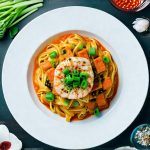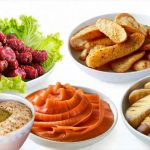Post-meal heaviness – that sluggish, uncomfortable feeling after eating – is an experience many people know all too well. It’s not necessarily about how much you eat, but often how you prepare and combine your food. Often mistaken for simple fullness, this sensation goes beyond satiety, manifesting as bloating, fatigue, or even mild digestive discomfort. The good news is that a thoughtful approach to food preparation can significantly lessen these effects, allowing you to enjoy your meals without the subsequent drag on energy levels and overall well-being. It’s about working with your body’s natural digestive processes rather than against them.
Understanding that digestion is an energetic process sheds light on why certain techniques work better than others. Our bodies expend considerable energy breaking down food, and if we can ease this burden through careful preparation methods, the result is a lighter, more comfortable post-meal experience. This isn’t about restrictive dieting or eliminating entire food groups; it’s about optimizing how we handle what we eat. Focusing on techniques that enhance digestibility, reduce complex combinations, and prioritize whole, unprocessed foods are key to feeling energized rather than weighed down after eating. It’s a holistic approach that acknowledges the interconnectedness of preparation, consumption, and well-being.
Optimizing Digestion Through Preparation Methods
The way we physically alter food before consuming it has a profound impact on how our bodies process it. Simply put, the more work your digestive system has to do, the heavier you’ll feel. Pre-digesting food through methods like soaking, sprouting, or fermenting can dramatically reduce this burden. Soaking nuts and seeds overnight, for instance, removes phytic acid – a compound that inhibits nutrient absorption and can contribute to bloating. Similarly, sprouting increases enzyme activity, making the nutrients more bioavailable and easier to digest. Fermented foods, rich in probiotics, further support gut health, which is fundamental to efficient digestion. You might also want to explore routine-friendly food choices that naturally aid this process.
Beyond these specific methods, cooking techniques play a crucial role. Steaming or gently sautéing vegetables preserves their nutritional value while making them easier on the digestive system compared to frying or roasting at high temperatures. Overcooking can destroy enzymes and alter the structure of food, hindering its breakdown. Choosing softer textures – think mashed sweet potatoes instead of crunchy fries – also reduces digestive effort. Combining these approaches—soaking legumes before gently simmering them, for example—creates a synergistic effect, maximizing digestibility and minimizing post-meal heaviness. It’s helpful to understand cooking techniques that minimize anti-nutrients too!
Finally, mindful combination is essential. The concept of food combining suggests that certain foods digest at different rates and combining incompatible pairings can lead to fermentation in the gut, causing bloating and discomfort. While not universally accepted as scientific fact, many find benefit from avoiding large amounts of protein with carbohydrates, or fruit consumed with meals (rather than between them). This is based on the idea that fruits digest rapidly while proteins and carbs take longer, leading to delayed digestion and potential fermentation. Experimenting with these principles can help identify individual sensitivities and optimize digestive comfort. Considering food sequence strategies might also be useful.
The Power of Soaking & Sprouting
Soaking isn’t just for nuts and seeds; grains like quinoa and brown rice also benefit greatly from pre-soaking. This process reduces their phytic acid content, improving nutrient absorption and making them easier to digest. For example:
1. Rinse the grain thoroughly.
2. Soak in water for several hours (typically overnight).
3. Drain and rinse again before cooking.
Sprouting takes this a step further by activating enzymes within the seed or grain. This results in a more nutritious and digestible food source. The sprouting process essentially initiates germination, making nutrients more accessible to your body. Sprouted lentils, for instance, are much easier to digest than their dried counterparts. They require less cooking time too! The mild flavor of sprouted grains makes them versatile additions to salads, soups, or even as a snack.
Beyond the digestive benefits, soaking and sprouting also enhance the nutritional profile of foods. Activated nutrients become more bioavailable, meaning your body can absorb and utilize them more effectively. This is particularly important for minerals like iron and zinc, which are often bound by phytic acid in unsoaked grains and seeds. Regularly incorporating soaked or sprouted foods into your diet supports overall health and reduces the likelihood of post-meal sluggishness. If you experience issues, consider tests that confirm potential food reactions.
Gentle Cooking Methods
The temperature at which we cook food significantly impacts its digestibility. High-heat cooking methods like frying can damage nutrients, create difficult-to-digest compounds, and contribute to inflammation. Gentle cooking methods, such as steaming, poaching, or slow cooking, preserve more of the food’s natural enzymes and structure. Steaming vegetables retains their vibrant color, texture, and nutritional content while making them easier to digest.
Slow cooking is another excellent option, particularly for tougher cuts of meat or legumes. The extended cooking time breaks down proteins and fibers, resulting in a tender and easily digestible meal. Using healthy fats like olive oil when sautéing can also aid digestion by helping the body absorb fat-soluble vitamins. Avoiding burnt or charred food is crucial, as these contain harmful compounds that can irritate the digestive system. A post-meal routine can further aid digestion.
Mindful Food Combining: A Personalized Approach
The idea behind food combining isn’t to restrict what you eat, but rather to optimize how you combine foods for better digestion. It’s based on the principle that different foods require different digestive enzymes and environments. For example, fruits digest quickly in a slightly acidic environment, while proteins require a more acidic stomach environment for breakdown. Combining them can lead to incomplete digestion and fermentation.
- Avoid combining large amounts of protein with carbohydrates (e.g., steak and mashed potatoes).
- Consume fruit on an empty stomach or between meals rather than with a full meal.
- Limit the combination of dairy with other foods, as many people experience lactose intolerance symptoms.
It’s important to remember that food combining is highly individual. What works for one person may not work for another. Paying attention to how your body responds to different combinations and adjusting your diet accordingly is key. Keep a food journal to identify potential triggers and optimize your digestive comfort. This isn’t about rigid rules, but rather mindful awareness of your body’s needs. If you are unsure what’s going on, diagnostics that explain reactions to food can be incredibly insightful.
The goal of these techniques isn’t just to avoid post-meal heaviness; it’s to cultivate a more harmonious relationship with food. By understanding how different preparation methods impact digestion, you can create meals that nourish your body and leave you feeling energized and vibrant. It’s about embracing the idea that food is medicine – and preparing it thoughtfully is an act of self-care.


















